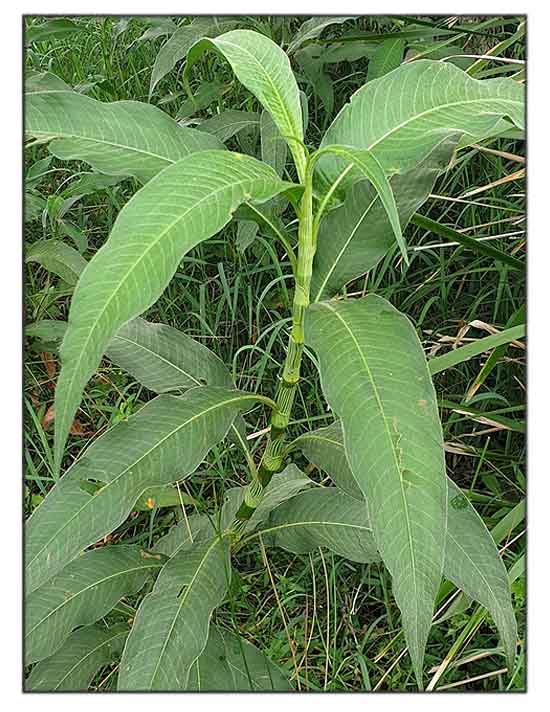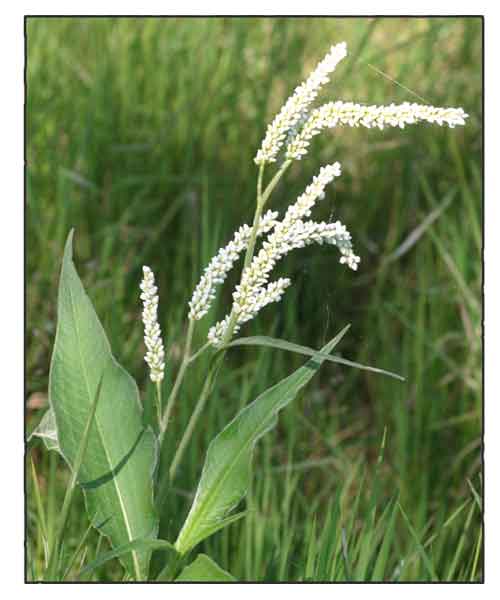
Family • Polygonaceae
Kakabkab
Subsuban
Persicaria attenuata (R.Br.) Sojak
HAIRY KNOTWEED
Mao er ye liao
| Scientific names | Common names |
| Persicaria attenuata (R.Br.) Sojak | Kakabkab (Maguindanao) |
| Polygonum articulatum R.Br. | Subsuban (Tagalog) |
| Polygonum attenuatum R.Br. | Hairy knotweed (Engl.) |
| Polygonum australe Spreng. | Smartweed (Engl.) |
| Polygonum brownii F.Dietr. | Velvet knotweed (Engl.) |
| Watersmart weed (Engl.) | |
| Persicaria attenuata is an accepted species. KEW: Plants of the World Online | |
| Note: In the confusing ecosystem of common names in the Philippines, subsuban (Tagalog) is shared by Persicaria barbata (Knot grass, Joint weed) and Persicaria attenuata. | |
| Other vernacular names |
| CHINA: Mao er ye liao, Mao er ye quan can. |
| INDONESIA: Jankong, Jukut carang (West Java), Bendet (Java). |
| LAOS: Nea paew. |
| MALAY: Johong beraleh. |
| SRI LANKA: Sudu kimbulwenna (Sinhala). |
| THAILAND: Uangphetma, Phakphai-nam, Dokkhaophot, Phong phot. |
| VIETNAM: Rau nghe. |
• Stout decumbent herb 60–100 cm high; stems glabrous or with very scattered long hairs; stalked glandular hairs sometimes present on stems, inflorescence branches and leaves. Leaves narrow-ovate, ± falcate, 8–20 cm long, 15–50 mm wide, variably pubescent, usually at least the margins and main veins with long white appressed hairs, lamina glabrous to subvillous, lower surface usually with sessile glands, less often glandular above; petiole 10–40 mm long; ocrea glabrous or sparsely hairy, with cilia 0–3 mm long. Spikes elongate-cylindrical, very dense, 4–11 cm long, 6–10 mm diam. Perianth segments 2.8–3.8 mm long, white. Achene lenticular, 2.0–2.5 mm long, 2.0–2.4 mm diam., dark brown to blackish. Distribution Constituents
Studies Availability |
August 2025
![]()
 |
| PHOTOS / ILLUSTRATIONS |
| IMAGE SOURCE: Persicaria attenuata: Velvet Knotweed / © pcopping / Some rights reserved / CC BY-NC / Click on image or link to go to source page / iNaturalist |
| OTHER IMAGE SOURCE: Persicaria attenuata: Velvet Knotweed / © nyoni-pete / Some rights reserved / CC BY-NC / Click on image or link to go to source page / iNaturalist |
Additional
Sources and Suggested Readings |
• |
DOI: It is not uncommon for links on studies/sources to change. Copying and pasting the information on the search window or using the DOI (if available) will often redirect to the new link page. (Citing and Using a (DOI) Digital Object Identifier) |
| List of Understudied Philippine Medicinal Plants |
| New plant names needed The compilation now numbers over 1,500 medicinal plants. While I believe there are hundreds more that can be added to the collection, they are becoming more difficult to find. If you have a plant to suggest for inclusion, native or introduced, please email the info: scientific name (most helpful), local plant name (if known), any known folkloric medicinal use, and, if possible, a photo. Your help will be greatly appreciated. |
• |
 |



